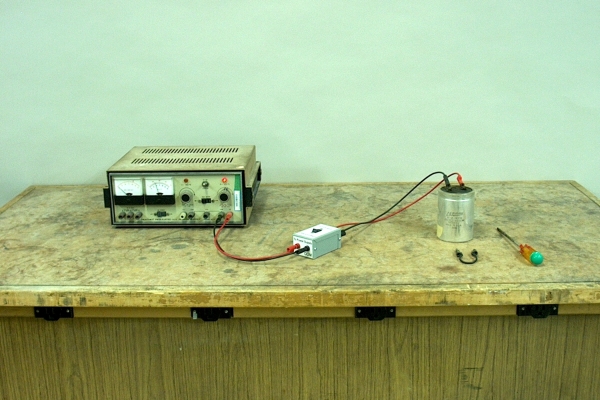
A video of this demonstration is available at this link.
You charge a 1000-μF capacitor to 400 volts with a power supply. Then you disconnect it from the power supply and place the screwdriver across its terminals.
This may not be the nicest thing to do to a capacitor, but it makes for an impressive demonstration.
The capacitor is connected to the power supply via a double-pole, double-throw switch, in the grey box in the photograph. Making sure that the DC output switch (toggle switch above and between voltage adjusting knobs) is on “Standby,” turn the AC power on and let the unit warm up for a few minutes. (It will probably be set up this way at the beginning of class.) Make sure that the voltmeter selector switch is set to the right, pointing to the B+ volts adjusting knob. Also make sure that the B+ volts knob is turned to zero (counterclockwise limit). If the switch is not already in the “Connect” position, press it to “Connect.”
Flip the toggle switch to “DC ON” and slowly turn up the voltage (B+). Each time you raise the voltage, you will see a spike in current, which in a capacitor equals C × dV/dt. Continue raising B+ until the control is at the maximum setting (fully clockwise, ~400 V). Because of the capacitor’s large size and internal resistance in the power supply, it takes some time for the current to drop to zero, at which point the capacitor is fully charged.
Press the rocker switch to “Disconnect” and flip the toggle switch to “Standby.”
Now short the capacitor terminals with the shaft of the screwdriver, and be ready for the loud crack from the giant spark that will occur when you do. This spark, of course, is the result of the sudden release of the energy stored in the capacitor, which occurs when you short the terminals. This energy is equal to (½)CV2, which for a 1000-μF capacitor at 400 volts equals 80 joules. (C = q/V, for which the units are coulombs/volt. One volt equals one newton·meter/coulomb, or one joule/coulomb. So the units of (½)CV2 are coulomb·volts, or joules.) If it were released in even as long as a few milliseconds, this would constitute a power output of several tens of thousands of watts!
If you wish to repeat the demonstration, make sure that you first turn the voltage all the way down. Then switch the power supply back on, and press the rocker switch to “Connect.” When you are finished, make sure that you have left the voltage turned down, and the power supply on “standby.”